Formwork Spring Clamps: Essential Tools for Efficient Construction
Formwork Spring Clamps: Essential Tools for Efficient Construction Table of Contents 1. Introduction to Formwork Spring Clamps 2. Understanding Formwork Spring Clamps 2.1 Definition and Purpose 2.2 Types of Formwork Spring Clamps 3. Benefits of Using Formwork Spring Clamps 4. Applications of Formwork Spring Clamps in Construction 5. In

Formwork Spring Clamps: Essential Tools for Efficient Construction
Table of Contents
- 1. Introduction to Formwork Spring Clamps
- 2. Understanding Formwork Spring Clamps
- 3. Benefits of Using Formwork Spring Clamps
- 4. Applications of Formwork Spring Clamps in Construction
- 5. Installation and Maintenance of Formwork Spring Clamps
- 6. Best Practices for Using Formwork Spring Clamps
- 7. Case Studies: Success Stories with Formwork Spring Clamps
- 8. Conclusion
- 9. Frequently Asked Questions
1. Introduction to Formwork Spring Clamps
In the construction industry, efficiency and safety are paramount. As projects grow in complexity and scale, the tools and methods employed must evolve accordingly. **Formwork spring clamps** have emerged as essential tools for ensuring that formwork is both securely held in place and easy to manage throughout the construction process.
2. Understanding Formwork Spring Clamps
2.1 Definition and Purpose
Formwork spring clamps are specialized devices designed to hold formwork panels together during the concrete pouring process. Their primary purpose is to maintain the integrity of the formwork, ensuring that it does not shift or collapse under the weight of wet concrete. These clamps significantly reduce the risk of accidents and material waste, making them vital for modern construction projects.
2.2 Types of Formwork Spring Clamps
There are several types of formwork spring clamps, each designed for specific applications. Understanding these types can help construction professionals select the right clamp for their needs:
1. **Standard Spring Clamps**: Basic clamps suitable for light to medium-duty applications.
2. **Heavy-Duty Spring Clamps**: Designed for more demanding applications where additional strength is required.
3. **Adjustable Spring Clamps**: Features that allow for easy adjustments to accommodate various formwork thicknesses.
4. **Locking Spring Clamps**: These clamps come with a locking mechanism for enhanced security, preventing accidental release.
3. Benefits of Using Formwork Spring Clamps
Employing **formwork spring clamps** in construction offers numerous benefits:
- **Enhanced Safety**: By securely fastening formwork, these clamps minimize the risk of accidents caused by shifting panels.
- **Increased Efficiency**: Quick installation and removal allow teams to work faster, reducing downtime.
- **Cost-Effectiveness**: The use of clamps reduces material waste and prevents costly rework due to formwork failure.
- **Versatility**: Suitable for various construction applications, from residential buildings to large commercial projects.
4. Applications of Formwork Spring Clamps in Construction
Formwork spring clamps are used in various construction contexts:
- **Concrete Pouring**: Their primary function is during the concrete pouring phase, ensuring that forms remain stable.
- **Precast Concrete Elements**: They assist in holding formwork for precast elements, allowing for high-quality construction with precise dimensions.
- **Tilt-Up Construction**: Used in tilt-up construction methods, where panels are set in place for quick assembly.
- **Retaining Walls**: Essential in forming retaining walls, ensuring that the concrete maintains its shape during curing.
5. Installation and Maintenance of Formwork Spring Clamps
5.1 Proper Installation Techniques
Installing formwork spring clamps correctly is crucial for optimal performance:
- **Positioning**: Ensure clamps are placed at regular intervals along the formwork to distribute pressure evenly.
- **Tensioning**: The clamps should be tightened to the manufacturer's specifications without over-tightening, which could damage the formwork.
- **Inspection**: Regularly check clamps for wear and damage before and during use to ensure reliability.
5.2 Maintenance Tips for Longevity
To extend the life of formwork spring clamps, consider the following maintenance practices:
- **Cleaning**: Remove concrete residue and dirt after each use to prevent deterioration.
- **Lubrication**: Apply lubricant to moving parts periodically to ensure smooth operation.
- **Storage**: Store clamps in a dry, secure location to avoid rust and damage.
6. Best Practices for Using Formwork Spring Clamps
Implementing best practices can enhance the effectiveness of formwork spring clamps:
- **Training**: Ensure workers are trained in the proper use and installation of clamps.
- **Regular Inspections**: Conduct frequent inspections to maintain safety standards and prevent accidents.
- **Documentation**: Keep records of clamp usage and maintenance to track performance over time.
7. Case Studies: Success Stories with Formwork Spring Clamps
Several construction projects have successfully incorporated formwork spring clamps, demonstrating their benefits:
- **Project A**: A high-rise building project that utilized heavy-duty clamps to secure formwork during concrete pouring, resulting in a 30% reduction in material waste.
- **Project B**: A commercial development that implemented adjustable spring clamps, allowing for quick adjustments, which sped up the construction timeline by two weeks.
8. Conclusion
Formwork spring clamps represent a critical advancement in construction techniques, providing safety, efficiency, and versatility. By effectively securing formwork during concrete applications, these clamps play an indispensable role in ensuring that construction projects run smoothly. As the industry continues to evolve, incorporating these essential tools will help construction professionals meet the growing demands for quality and efficiency.
9. Frequently Asked Questions
What are the different types of formwork spring clamps?
There are several types, including standard, heavy-duty, adjustable, and locking spring clamps, each designed for specific applications.
How do you install formwork spring clamps properly?
Position the clamps at regular intervals, ensure the correct tension, and conduct regular inspections for safety.
What are the benefits of using these clamps in construction?
Benefits include enhanced safety, increased efficiency, cost-effectiveness, and versatility across various applications.
How do you maintain formwork spring clamps?
Cleaning after use, lubricating moving parts, and storing them in a dry place can help maintain their longevity.
Can formwork spring clamps be used for precast concrete elements?
Yes, they are ideal for securing formwork during the formation of precast concrete elements, ensuring precision and quality.
By understanding the importance and functionality of formwork spring clamps, construction professionals can enhance their project outcomes, ensuring safety and efficiency from start to finish.
Key words:
PREVIOUS:
PRODUCT SEARCH
Search And Quickly Find The Products You Need
With advantages in technology, quality, and service, the company is steadily advancing in the industry, continuously providing high-quality hydraulic rubber products and services to global customers, demonstrating strong development potential and broad market prospects.










